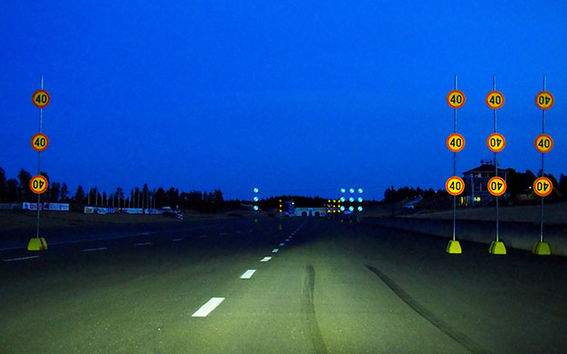Traffic signs can be difficult to see with new types of headlights

In his master's thesis for Aalto University, Lauri Ahtiainen studied the evolution of vehicle headlights and its effect on the visibility of traffic signs, whilst Kaisa Reunanen examined the impact that traffic sign ageing and placement has on their visibility in her master's thesis.
Both theses arrived at roughly the same conclusion: A minimum value for diffused lights should be set for regulations concerning vehicle headlights in order to ensure adequate illumination.
Diffused light illuminates signs
Due to their high light output, Xenon and LED headlights can dazzle oncoming motorists. This is why it was necessary to place precise restrictions on the beam pattern for low beam headlights where the vertical axis is concerned.
Due to this precise restriction, only a small amount of diffused light is emitted outside the actual beam pattern. This can compromise the visibility of traffic signs, as traffic signs are usually placed well outside the area illuminated by beam patterns.
‘Halogen headlights often discharge more diffused light than the new technologies, which makes it easier to see signs. In addition to diffused light, light reflected from the surface of the road also illuminates traffic signs,’ explains Ahtiainen.
Detectability deteriorates with age
Ahtiainen and Reunanen studied the detectability of traffic signs using four vehicles: two with LED headlights, one with Xenon headlights and one with conventional halogen headlights.
Observations were made by six test drivers: some young and some over 50 years in age. The researchers also measured the retroreflectivity of traffic signs.
Traffic signs were placed in groups at different heights. All the signs were placed in an area compliant with Finnish Transport Agency specifications.
‘The younger drivers saw all the traffic signs perfectly with all the headlight types. Older drivers didn't see the uppermost signs when driving vehicles fitted with LED or Xenon headlights,’ explains Ahtiainen.
Traffic signs were most visible when using halogen headlights, because they emit a comparatively large amount of diffused light. As a result, the contrast between the brightness of the road surface and placement area of the signs was lower than when using LED and Xenon headlights.
According to Ahtiainen, difficulty in seeing traffic signs compromises traffic safety.
The current headlight beam pattern in use is based on a recommendation made by the European Commission. Ahtiainen proposes that a minimum value be included in the recommendation for diffused light.
‘Technically, increasing the amount of diffused light in LED and Xenon headlights would be easy,’ says Ahtiainen.
Reflectivity decreases over time
Kaisa Reunanen surveyed approximately 260 traffic signs on roads throughout the Uusimaa region. In the survey, the condition of the signs was assessed visually and their retroreflectivity was measured.
The signs were assessed in the study in accordance with Finnish Transport Agency specifications. Here, the signs were divided into five condition values (1-5), in which a condition value of 5 would indicate a new or mostly new sign.
A majority of the signs surveyed had a condition value of 3. Although these signs contained a small amount of damage, this damage had no impact on their detectability. One out of every ten signs was in poor condition, i.e. condition value 2.
‘As a rule, the older the sign, the poorer the reflectivity. Retroreflectivity, however, does not decrease linearly over time. In other words, the retroreflectivity values for signs that are the same age or have the same condition value vary widely,’ states Reunanen.
According to Reunanen, an assessment made during daylight hours is not enough to ensure that the sign will be visible in the dark. Actually, retroreflectivity is not even one of the criteria used to assess the need for sign repair/replacement.
‘The most effective way to ensure sign visibility is to keep them in good condition. If necessary, the retroreflectivity of signs should be measured, at least if a sign is given a condition value of 3,’ says Reunanen.
Using current methods, measuring is a laborious process. However, according to Reunanen, one solution might be to automate measurements or make visual condition assessments when it is dark.
The test subjects participating in the field test made far more mistakes in detecting old signs (they were either hard to see or went completely undetected) than new signs.
‘The age of test subjects had a clear impact on visibility; young people saw all signs without problems, 50- and 60-year old subjects not so well.’
The signs were slightly more visible when using halogen headlights than when using LED or Xenon headlights. Reunanen also recommended that a minimum value for diffused light be included in regulations for vehicle headlights.
Reunanen would also add a maximum limit for retroreflectivity to specifications concerning signs in order to ensure that the new signs will not have too much glare. In Finland, this type of glare is prevented by only placing signs with a higher retroreflectivity value for mounting above the road.
According to current specifications, signs are to be placed at a high level in order to minimise collisions with snowploughs as well as being covered by the snow thrown from them. Based on the field tests conducted, sign placement is good.
Kaisa Reunanen studied Transportation and Highway Engineering at Aalto University and Lauri Ahtiainen Vehicle Engineering.
Further information:
Kaisa Reunanen: ek.reunanen(at)gmail.com
Lauri Ahtiainen: lauri.ahtiainen(at)me.com
- Published:
- Updated:
Read more news

Online AI course could boost study equality
Students at the School of Business believe that mastering Artificial Intelligence (AI) can be beneficial for both academic success and career prospects, as AI becomes increasingly integrated into daily life.
2 027 new students admitted to Aalto University’s Finnish, Swedish bachelor’s programmes
13 500 applied to Aalto University in Finland's spring joint application in 2024
Meet the the Program Assistants that elevate the Aalto University Summer School experience for 250 students from all over the world
Each year, the Aalto University Summer School has grown its operations and course curriculum tremendously.